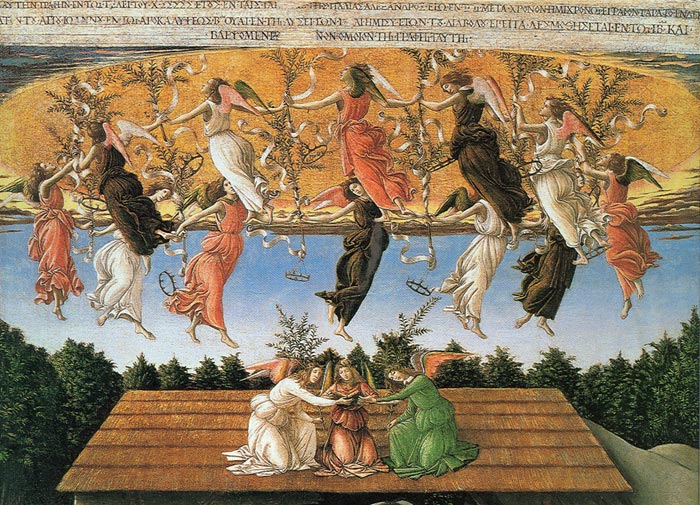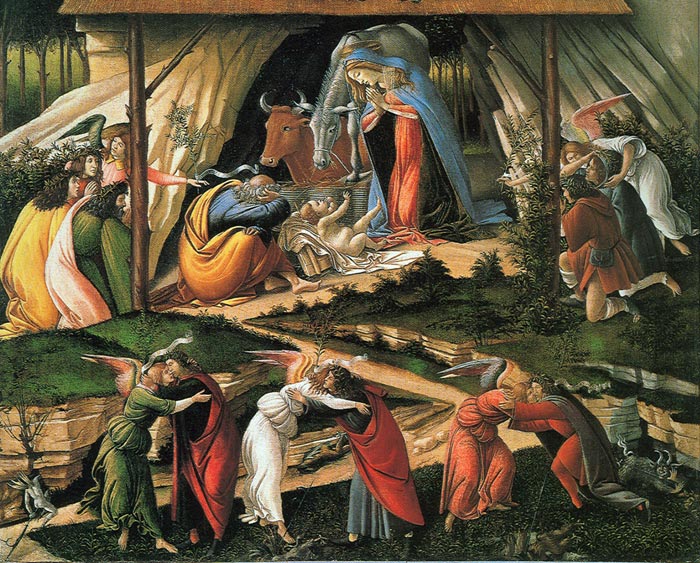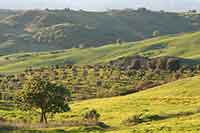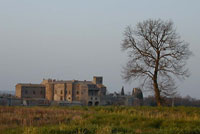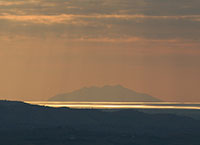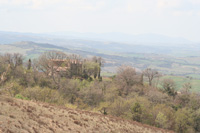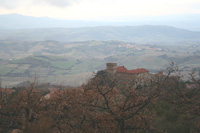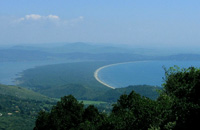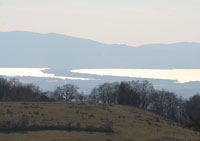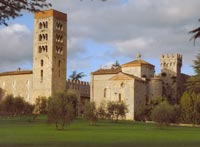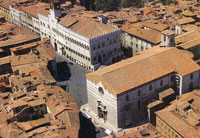The Mystical Nativity is a painting of circa 1500-1501 by the Italian Renaissance master Sandro Botticelli, in the National Gallery in London. Botticelli built up the image using oil paint on canvas. It is his only signed work, and has a very unusual iconography for a Nativity.
It has been suggested that this picture, the only surviving work signed by Botticelli, was painted for his own private devotions, or for someone close to him. It is certainly unconventional, and does not simply represent the traditional events of the birth of Jesus and the adoration of the shepherds and the Magi or Wise Men. Rather it is a vision of these events inspired by the prophecies in the Revelation of Saint John. Botticelli has underlined the non-realism of the picture by including Latin and Greek texts, and by adopting the conventions of medieval art, such as discrepancies in scale, for symbolic ends. The Virgin Mary, adoring a gigantic infant Jesus, is so large that were she to stand she could not fit under the thatch roof of the stable. They are, of course, the holiest and the most important persons in the painting.
The angels carry olive branches, which two of them have presented to the men they embrace in the foreground. These men, as well as the presumed shepherds in their short hooded garments on the right and the long-gowned Magi on the left, are all crowned with olive, an emblem of peace. The scrolls wound about the branches in the foreground, combined with some of those held by the angels dancing in the sky, read: 'Glory to God in the highest, and on earth peace, goodwill toward men' (Luke 2:14). As angels and men move ever closer, from right to left, to embrace, little devils scatter into holes in the ground. The scrolls held by the angels pointing to the crib once read: `Behold the Lamb of God, which taketh away the sin of the world' the words of John the Baptist presenting Christ (John 1:29). Above the stable roof the sky has opened to reveal the golden light of paradise. Golden crowns hang down from the dancing angels' olive branches. Most of their scrolls celebrate Mary: 'Mother of God', 'Bride of God', 'Sole Queen of the World'.
The puzzling Greek inscription at the top of the picture has been translated: 'I Sandro made this picture at the conclusion of the year 1500 in the troubles of Italy in the half time after the time according to the 11th chapter of Saint John in the second woe of the Apocalypse during the loosing of the devil for three and a half years then he will be chained in the 12th chapter and we shall see [...] as in this picture.' The missing words may have been 'him burying himself'. The 'half time after the time' has been generally understood as a year and a half earlier, that is, in 1498, when the French invaded Italy, but it may mean a half millennium (500 years) after a millennium (1000 years): 1500, the date of the painting. Like the end of the millennium in the year 1000, the end of the half millennium in 1500 also seemed to many people to herald the Second Coming of Christ, prophesied in Revelation.
At a time when Florentine painters were recreating nature with their brush, Botticelli freely acknowledged the artificiality of art. In the pagan Venus and Mars he turned his back on naturalism in order to express ideal beauty. In the 'Mystic Nativity' he went further, beyond the old-fashioned to the archaic, to express spiritual truths - rather like the Victorians who were to rediscover him in the nineteenth century, and who associated the Gothic style with an 'Age of Faith'.
The painting emerged from the city of Florence in a time when the fanatical preacher Savonarola held the city in its grip. There is no documentary evidence to prove whether or not Botticelli was one of Savonarola's follower. But certain themes in his later works - like the Mystic Nativity - are certainly derived from the sermons of Savonarola, which means that the artist was definitely attracted by that personality so central to the cultural and political events of Florence during the last years of the fifteenth century.[1]
The painting is on canvas - normally he would have used wood panel - perhaps for a painting with a dangerous message, canvas had the advantage that it could be rolled up and hidden. With his canvas prepared he would sketch a detailed design on paper, then he transferred this to canvas. He drew on many sources - the dancing angels echo his own three graces of Primavera, the scurrying devil was inspired by a German woodcut. X-rays show that very little of the original design changed - only an angel's wing was adjusted and trees added over the roof of the stable. Botticelli was now ready to build up the image using oil paint - like canvas an experimental medium. To create the heavenly dome Botticelli called on the goldsmith's craft he had learned as a boy. "The symbolism of the gold is to do with the unchanging, untarnished nature of heaven - gold doesn't decay, it doesn't darken like silver. Botticelli would have used an adhesive layer made of oil mixed with resin - not burnished , the gold just patted down on to the surface, following the surface irregularities of the canvas - a glitter, intricate, it would have helped the jewel like quality of the painting - it would have drawn the eye upwards from the Nativity into Heaven. Faith, hope and charity,[the angels clothed in] white, green and red - but the copper based green pigment has discoloured with time, to bronze. Originally it would have been vibrant." |
|
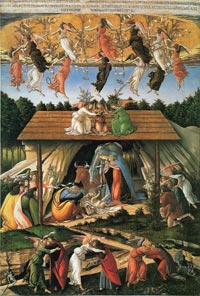 Sandro Botticelli, Mystical Nativity, London, National Gallery Sandro Botticelli, Mystical Nativity, London, National Gallery
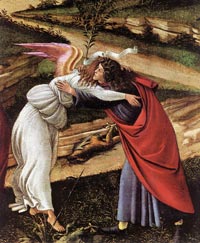 The birth of the Child will bring salvation. Angels and people are embracing, and little devils are hiding themselves in holes in the earth. The birth of the Child will bring salvation. Angels and people are embracing, and little devils are hiding themselves in holes in the earth.
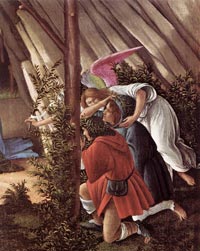 Shepherds wearing wreaths are kneeling to each side of Mary, their attention drawn by angels to what is happening. Shepherds wearing wreaths are kneeling to each side of Mary, their attention drawn by angels to what is happening.
|
Botticelli died in 1510. The Mystic Nativity remained hidden for another three centuries. Rome at the end of the 18th century was very different to Renaissance Florence - except for the presence of French invaders. Many foreigners left, but not a young Englishman, William Young Ottley. He was an art lover, and wealthy with a slave plantation in the Caribbean. He bought up many paintings cheaply. At the Villa Aldobrandini he saw a small, unknown work, Botticelli's Mystic Nativity. Botticelli was then in obscurity.
It arrived in London where Ottley's house became in effect a private museum of Italian masterpieces. After Ottley's death William Fuller-Maitland of Stansted picked up the painting at an auction for £80. When he loaned it to the Art Treasures Exhibition, Manchester 1857, it was now on open display. The Exhibition's newspaper the Art Treasures Examiner printed a new engraving of it.
From the moment Botticelli's art is shown in Manchester there's a real change in opinion about his work and certainly by the late 1870s, 1880s Botticelli becomes a real cult figure - somebody the artists who aspire to be on the cutting edge of the art world are looking to...Dante Gabriel Rossetti and Edward Burne-Jones both adapted elements of it for their own work. Burne-Jones copied some of Botticelli's illustrations for Dante's Divine Comedy into his own sketchbooks. Rossetti demonstrated his affection for Botticelli's work by buying his portrait of Smeralda Bandinelli in 1867.
John Ruskin helped to give the painting its name; after seeing it in London he referred to Botticelli's 'mystic symbolism'. When Maitland died the National Gallery in London stepped in. According to Nicholas Penny the Gallery "was concerned to buy works from the earlier Renaissance - previously it had been its top priority to buy masterpieces which there would be no controversy about at all. There was an element of avant-garde excitement about buying pictures like this in the 19th century." The Gallery had to find £1500, being nearly 20 times what it had fetched just thirty years earlier.
Edward Burne-Jones was a British painter, illustrator, and designer. At Oxford he met his future collaborator, William Morris. In 1856 he became apprenticed to Dante Gabriel Rossetti. His paintings portray the romantic medieval imagery favoured by the Pre-Raphaelites, and he drew inspiration from the elongated, melancholy figures of Fra Filippo Lippi and Sandro Botticelli.
Visits to Italy in 1859 and 1862 resulted in a noticeable change in Burne-Jones's style, under the influence of such Renaissance painters as Andrea Mantegna, Sandro Botticelli, and Michelangelo.
This highly mannered style of dreamy, literary romance exaggerates and encapsulates the subject and gives it an other-world intensity that would be lost on a bigger canvas. This also altered the perception of perspective: either particularly deep or very compressed.
|
|
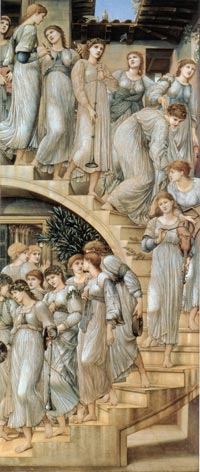
"All those little toes that are climbing down the stairs - you can see the fascination with the patterns of the toes that are circling in the angels of the Mystic Nativity ...The Mystic Nativity worked a particular magic on members of the Pre-Raphaelite circle." Edward Burne-Jones's The Golden Stairs, 1876-1880, The Tate Gallery, London
|
